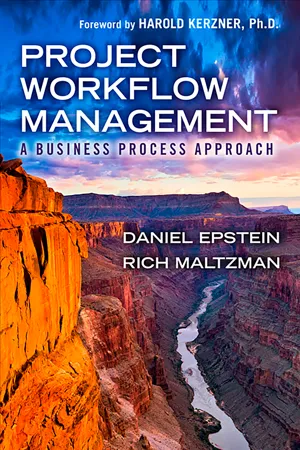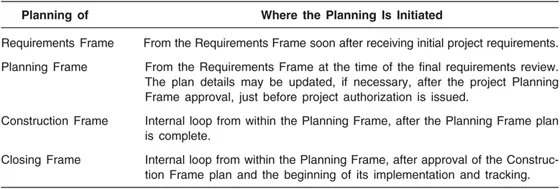
- 352 pages
- English
- ePUB (mobile friendly)
- Available on iOS & Android
eBook - ePub
About this book
Foreword by industry legend Harold Kerzner! This book describes a completely unique step-by-step, workflow-guiding approach to project management which simplifies activities by enforcing execution of all required processes on time, and redirecting to an alternative path in the event of project issues. Since compliance with all project management processes is enforced by the workflow, product quality is significantly improved and life cycle errors are almost eliminated. Project Workflow Management: A Business Process Approach is the first and only book in the marketplace which enables readers with no prior project management experience to manage the entire life cycle of any small to mid-sized project. It also equips mid- and senior-level project managers with directions and a detailed map to the effective management of complex projects and programs.
Frequently asked questions
Yes, you can cancel anytime from the Subscription tab in your account settings on the Perlego website. Your subscription will stay active until the end of your current billing period. Learn how to cancel your subscription.
At the moment all of our mobile-responsive ePub books are available to download via the app. Most of our PDFs are also available to download and we're working on making the final remaining ones downloadable now. Learn more here.
Perlego offers two plans: Essential and Complete
- Essential is ideal for learners and professionals who enjoy exploring a wide range of subjects. Access the Essential Library with 800,000+ trusted titles and best-sellers across business, personal growth, and the humanities. Includes unlimited reading time and Standard Read Aloud voice.
- Complete: Perfect for advanced learners and researchers needing full, unrestricted access. Unlock 1.4M+ books across hundreds of subjects, including academic and specialized titles. The Complete Plan also includes advanced features like Premium Read Aloud and Research Assistant.
We are an online textbook subscription service, where you can get access to an entire online library for less than the price of a single book per month. With over 1 million books across 1000+ topics, we’ve got you covered! Learn more here.
Look out for the read-aloud symbol on your next book to see if you can listen to it. The read-aloud tool reads text aloud for you, highlighting the text as it is being read. You can pause it, speed it up and slow it down. Learn more here.
Yes! You can use the Perlego app on both iOS or Android devices to read anytime, anywhere — even offline. Perfect for commutes or when you’re on the go.
Please note we cannot support devices running on iOS 13 and Android 7 or earlier. Learn more about using the app.
Please note we cannot support devices running on iOS 13 and Android 7 or earlier. Learn more about using the app.
Yes, you can access Project Workflow Management by Dan Epstein,Rich Maltzman in PDF and/or ePUB format, as well as other popular books in Business & Project Management. We have over one million books available in our catalogue for you to explore.
Information
Section III.
Planning/High-Level Design Frame

Planning/High-Level Design Frame Process Flow
Introduction
The purpose of the project planning process is to develop plans for executing and controlling all project frames and processes within each frame. This chapter details how to break down project tasks, estimate them, package them and then, equally important, communicate the detailed project plan. The Planning Frame consists of the following major elements:













Table 5.1 Frames Planning Initiation Source

The combination of the above elements is used to develop plans for all project activities that have a major impact on project cost, duration and quality. The more thorough the project plan, the more predictable the project cost and schedule.
All activities require planning. This includes planning of the Planning Frame, since the Planning Frame activities include plans for high-level design, plans for risk management, plans for quality management, etc. Planning of all project activities and the overall project is always done in the Planning Frame, but may be initiated in other frames. Where the planning of each frame is initiated is shown in Table 5.1.

The Construction Frame planning may start early, in the middle of the Planning Frame planning, but in order to complete the plan, it is necessary to be in the advanced stages of the Planning Frame planning. If most of the Planning Frame is not complete, there is not sufficient information available for planning of the detailed design and implementation, which are parts of the Construction Frame. Similarly, in order to complete the plan for the Closing Frame, it is necessary to be in the advanced stages of the Construction Frame implementation.
Roles and Responsibilities
The following roles and responsibilities will be required in the Planning/High-Level Design Frame:








Inputs/Outputs
The Planning Frame processes interact with all project frames via the entry and exit points,...
Table of contents
- Cover
- Read the Reviews
- Title
- Copyright
- Table of Contents
- Foreword by Dr. Harold Kerzner
- Introduction
- Acknowledgments
- About the Authors
- Web Added Value™
- SECTION I. PROJECT MANAGEMENT OVERVIEW
- SECTION II. REQUIREMENTS FRAME
- SECTION III. PLANNING/HIGH-LEVEL DESIGN FRAME
- SECTION IV. CONSTRUCTION/TRACKING FRAME
- SECTION V. CLOSING/TESTING FRAME
- Appendices